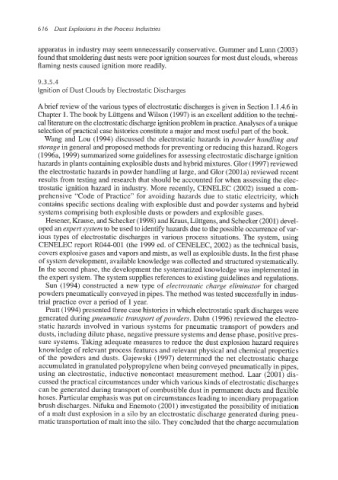Page 649 - Dust Explosions in the Process Industries
P. 649
6 16 Dust Explosions in the Process Industries
apparatus in industry may seem unnecessarily conservative. Gummer and Lunn (2003)
found that smoldering dust nests were poor ignition sources for most dust clouds, whereas
flaming nests caused ignition more readily.
9.3.5.4
Ignition of Dust Clouds by Electrostatic Discharges
A brief review of the various types of electrostaticdischargesis given in Section 1.1.4.6in
Chapter 1. The book by Luttgens and Wilson (1997) is an excellent addition to the techni-
cal literatureon the electrostaticdischargeignitionproblem in practice.Analyses of a unique
selection of practical case histories constitute a major and most useful part of the book.
Wang and Lou (1994) discussed the electrostatic hazards in powder handling and
storage in general and proposed methods for preventing or reducing this hazard. Rogers
(1996a, 1999)summarized some guidelinesfor assessing electrostaticdischarge ignition
hazards in plants containing explosibledusts and hybrid mixtures. Glor (1997) reviewed
the electrostatic hazards in powder handling at large, and Glor (2001a) reviewed recent
results from testing and research that should be accounted for when assessing the elec-
trostatic ignition hazard in industry. More recently, CENELEC (2002) issued a com-
prehensive “Code of Practice” for avoiding hazards due to static electricity, which
contains specific sections dealing with explosible dust and powder systems and hybrid
systems comprising both explosible dusts or powders and explosible gases.
Hesener, Krause, and Schecker(1998) and Kraus, Luttgens, and Schecker (2001) devel-
oped an expert system to be used to identify hazards due to the possible occurrence of var-
ious types of electrostatic discharges in various process situations. The system, using
CENELEC report R044-001 (the 1999 ed. of CENELEC, 2002) as the technical basis,
covers explosive gases and vapors and mists, as well as explosible dusts. In the first phase
of system development, availableknowledge was collected and structured systematically.
In the second phase, the developmentthe systematized knowledge was implemented in
the expert system.The system suppliesreferences to existing guidelines and regulations.
Sun (1994) constructed a new type of electrostatic charge eliminator for charged
powders pneumaticallyconveyed in pipes. The method was tested successfully in indus-
trial practice over a period of 1 year.
Pratt (1994) presented three case histories in which electrostaticspark discharges were
generated during pneumatic transport ofpowders. Dahn (1996) reviewed the electro-
static hazards involved in various systems for pneumatic transport of powders and
dusts, including dilute phase, negative pressure systems and dense phase, positive pres-
sure systems. Taking adequate measures to reduce the dust explosion hazard requires
knowledge of relevant process features and relevant physical and chemical properties
of the powders and dusts. Gajewski (1997) determined the net electrostatic charge
accumulatedin granulatedpolypropylenewhen being conveyedpneumaticallyin pipes,
using an electrostatic, inductive noncontact measurement method. Laar (2001) dis-
cussed the practical circumstancesunder which various kinds of electrostaticdischarges
can be generated during transport of combustible dust in permanent ducts and flexible
hoses. Particular emphasis was put on circumstances leading to incendiary propagation
brush discharges. Nifuku and Enemoto (2001) investigated the possibility of initiation
of a malt dust explosion in a silo by an electrostatic discharge generated during pneu-
matic transportation of malt into the silo. They concluded that the charge accumulation

